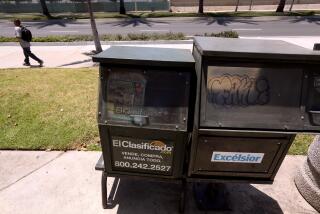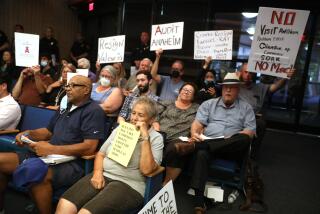Cities Should Be Able to Ban Billboards, Official Testifies
- Share via
WASHINGTON — Agoura Hills Councilwoman Fran Pavley, reflecting on her city’s futile eight-year fight to remove 30 billboards along the Ventura Freeway, told a House subcommittee Thursday that local governments should be given the clout to banish unsightly roadside signs.
Pavley testified before the House Public Works surface transportation subcommittee that the key impediment under the current federal law is a requirement that localities compensate billboard companies for removing their advertisements.
The city or county must reimburse the owner for the sign’s value as well as for the revenues that would be lost by dismantling it.
This has allowed the firms, in effect, to set their own price, which can be as much as $100,000, Pavley said. Since 1982, the federal government has not allocated funds for such payments, leaving the costs to local taxpayers. As a result, the billboards often remain.
“I am continually asked by local residents, ‘Why can’t you do something about those billboards?”’ said Pavley, who was Agoura Hills’ first mayor when the city was formed in 1982.
“They don’t understand why the state and federal governments can regulate this undesirable land use within our city limits.”
Pavley was one of several witnesses who testified in support of a bill that would represent the first major revision of the Highway Beautification Act of 1965, which limits billboards on federal interstate highways and roads but which critics say is riddled with loopholes.
Scenic America, a national conservation organization, maintains that the heralded law’s inherent flaws and subsequent weakening amendments have rendered it ineffective.
“Without reform, America’s traveling public will continue to be bombarded by visual blight and information overload,” said Edward T. McMahon, Scenic America’s executive director.
Los Angeles is the “billboard capital of the world,” McMahon said. Residents on its traffic-clogged streets are exposed to 9,000 to 10,000 outdoor signs, with the heaviest concentrations pitching cigarettes and liquor in low-income areas, he added. A bill to ban new billboards in the city was narrowly defeated in 1988 amid heavy lobbying by the sign industry.
The pending federal measure would allow state and local governments to decide the terms under which existing billboards would be removed, eliminate the requirement that municipalities pay billboard companies to take down signs, place a moratorium on the construction of new billboards on federal highways, and prohibit the destruction of trees to improve billboard visibility.
The proposal is opposed by the politically formidable billboard industry.
“We feel that the current legislation is working well,” said Kippy Burns, an Outdoor Advertising Assn. spokeswoman. “You can’t get much stricter than allowing each individual state to enact billboard controls . . . all the way up to banning billboards.”
She noted that Maine, Vermont, Alaska and Hawaii have banned roadside billboards. In addition, more than 500 cities either prohibited or restricted outdoor advertising.
The Washington-based advertising association represents 295 billboard companies, or 80% of the $1.6-billion industry. Nationwide, there are 390,294 billboards on federal and interstate highways and an overall total of 500,000.
Pavley, who was speaking on behalf of the National League of Cities and the League of California Cities on Thursday, said Agoura Hills banned new billboards in 1982. But it remains deeply frustrated over the otherwise-scenic 3 1/2-mile stretch of the Ventura Freeway where most of the 30 signs prominently advertise products or businesses outside the city’s limits.
“Courts have approved the use of zoning to relocate junkyards, cement factories, taxidermists, shelters, garbage dumps and other land uses,” Pavley testified. “Today only billboards are being singled out for special protection by Congress.”
Billboard opponents’ efforts to pass stricter controls were defeated in 1987 in a House and Senate conference committee.
More to Read
Sign up for Essential California
The most important California stories and recommendations in your inbox every morning.
You may occasionally receive promotional content from the Los Angeles Times.










